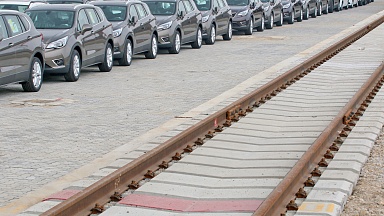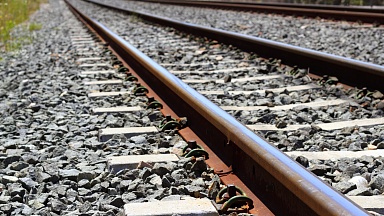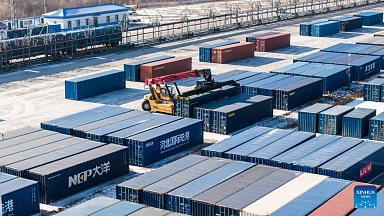— Given the ongoing changes in global markets, how would you describe Russian Railways’ international rail transport operations last year?
— The Russian Railways Holding Company consistently fulfills all the tasks assigned to it by the President and the Government of the Russian Federation in terms of building a solid transportation and logistics foundation for our country’s foreign economic relations.
International rail transport operations continued last year despite unprecedented sanctions pressure. We increased volumes by 2.6%, reaching more than half a billion tons.
Container transportation across the network as a whole reached a historic high of 7.4 million TEUs, which is 14% higher than in 2022 with around 60% of the containerized cargoes being international.

— Which countries are currently experiencing growth in transportation and cargo delivery services? How has the variety of Russian cargoes evolved over the past two years?
— For us, transportation of cargoes to and from «friendly countries» is the first priority. Their share in total exports in 2023 exceeded 81% (351 million tons with an increase of about 45%).
In terms of destinations, China remains our main partner in the East with more than 161 million tons of cargoes shipped by rail in 2023 (+36% over 2022).
CIS countries, UAE, Turkey and India are also on top of the list. At the end of the year, exports to certain destinations increased 2-3 times. We are talking tens of millions of tons.
Transportation and logistics corridors in the Eastern and Azov-Black Sea directions, as well as the North-West and the North-South ITC are still the main thoroughfares for cargo delivery today.
In coordination with the Russian Federation’s government, the holding company is carrying out a number of initiatives to expand these corridors.
Transportation in the North-West direction is rapidly expanding; at the end of 2023, about 220.4 million tons of various cargoes were moved (+4.8% year on year).
We are collaborating with Belarusian partners to develop innovative port approaches. An agreement was signed with Belarusian Railways to cooperate on modernizing/developing sections of public railway transport infrastructure in order to increase the volume of cargo transported along the 9th transport corridor to ports in the Russian Federation’s North-West region.
The decision was made to prepare a joint action plan for the implementation of the Union Program to ensure the functioning of the unified transport system of the Union State.
The last year’s figures indicate that the volume of transportation along the Azov-Black Sea direction was roughly equal to that of 2022, while grain export shipments actually doubled to 13.9 million tons.
The North-South ITC carried 12.5 million tons in 2023. Oil cargoes, grain, construction cargoes, timber cargoes, and ferrous metals were the most commonly transported cargoes in export traffic of 9.7 million tons (+9%).
The Eastern direction (ports of the Far East, border crossings with China, Mongolia and Kazakhstan), showcased an increase of 6.3% to 264.7 million tons versus 2022, including exports that increased by 8.8% reaching 181.4 million tons.
Transportation through border crossings with China, in particular, is expanding, with exports increasing by one-third to 33.6 million tons as coal and ore exports rise. Containerized cargo transportation has been ascending as regular transportation of containers began through the Nizhneleninskoye-Tongjiang bridge border crossing which opened in 2022.
Transportation across Kazakhstan’s border crossings climbed by 5% to 92.1 million tons, including exports up 21.1% to 28.4 million tons.
Volumes moved through border crossings with Mongolia have increased rapidly, by 39.2% versus 2022, including exports up 44.7% due to a rise in paper and oil cargo shipments.
— Do foreign companies use the China-Europe-China corridor and to what extent?
— For obvious reasons, the China — Europe — China direction saw the greatest decline. However, both cargo owners and international experts agree that transit through Russia still remains the most cost-effective and time-efficient mode of transportation. This is one of the reasons for transit’s recent revival, along with reliability, stability and service quality.
Our partners are leveraging the newly available infrastructure capacities effectively. For example, container shipments of Belarusian goods to China have surged by 85%, reaching over 350,000 TEUs.
— What is the current status of the development of cross-border railway infrastructure?
— As a result of reorientation of foreign trade flows, railroad border crossings with China, Kazakhstan and Azerbaijan bear the heaviest strain.
Ensuring their sufficient throughput capacity and introducing cutting-edge technologies is one of the company’s priorities.
Specialized government agencies and local authorities are making a concerted effort to accomplish these tasks. In its part, JSC Russian Railways is implementing the investment project «Development of Railway Checkpoint Infrastructure».
The project provides for developing and modernizing the railway infrastructure at a number of border stations among which are Zabaikalsk, Grodekovo, Naushki, Derbent (construction of the new Samur-II railway station), Aksarayskaya, Kartaly, Orsk, Kulunda, Isilkul, as well as revamping the railway checkpoint Makhalino (Kamyshovaya station).
— How is North-South ITC freight transportation developing today, and what has Russian Railways already done to accomplish this?
— The North-South ITC is being developed under close scrutiny at all levels. As is known, preparations are underway on its western route to build a rail line section between Astara and Resht on the basis of the Russian-Iranian intergovernmental agreement signed last year in the presence of the heads of state of Russia and Iran. The purpose is to establish a continuous rail connection along this route without transshipping cargoes to other modes of transport.
Russian Railways, for its part, is designing and surveying the Derbent-Samur segment, as well as building and installing the Derbent border crossing, according to schedule. We intend to boost the section’s throughput capacity to 20 million tons by the end of 2027.
Furthermore, we are consistently «rolling out» the eastern route of the corridor. On this route, regular container service has been organized since 2022, with a frequency increase to four trains a month last year.
We are actively utilizing the tariff preferences mechanism, as agreed upon with our colleagues in Kazakhstan, Turkmenistan, and Iran.
By taking these steps, we are confident that the volume of transportation in the corridor will increase dramatically along all routes and its role in ensuring Russia’s foreign economic relations will be significantly boosted.
— What issues are gaining significant attention from international organizations today?
— First and foremost, we are focused on creating the most favorable legal, organizational and technical conditions for international transportation service.
The Organization for Cooperation between Railways (OCBR) fully ensures the improvement of current agreements and the formation of new contracts establishing transportation conditions from Central Europe to the Asia-Pacific Region.
Last year, for example, revisions were made to the rules governing the carriage of hazardous commodities, and work was started to develop a standard for railway communication based on 5G technology.
The EAEU has approved the Roadmap for the expansion of trade and economic cooperation between the EAEU and the People’s Republic of China. In February 2024, the three EAEU member states signed a Memorandum of Understanding on the Harmonized Development of Transport and Logistics Potential for Railway Transport.
The Council for Railway Transport of the Commonwealth member states continued its work to regulate all the aspects of joint transportation technology, mutual settlements, and information exchange between the railways in the CIS countries and other members of the Council. The Strategic Development Plan for Railway Transportation in the «1520-gauge space» until 2030, which was approved by the CIS Council of Heads of Government at the close of 2021, is being effectively implemented.
Amidst ongoing geopolitical changes, the Council’s work functions were expanded in 2023. Starting from July 2023, the rules of integrated settlements between railway administrations have been amended to include a clearing settlement mechanism that minimizes banks’ involvement in financial transactions between participants and streamlines the financial flows.
I would like to emphasize that considering the history of positive experience and technological connectivity, which is a natural competitive edge in the Euro-Asian space, the vast majority of our partners in the «1520-guage space» are still very interested in developing mutually beneficial business relations with Russian Railways. We, by whom I mean all those employed in the railway industry, find common ground in a positive dialogue and a sense of coherence in what we do. Border crossings, paperless technology, logistics know-how, and other transport-related concerns are at the center of our collaborative focus.
Railway Transport Council of Commonwealth Member States (which celebrated its 30-year anniversary in 2022) has been instrumental in coordinating these efforts over decades.
Given its significance, I would like to point out one particular aspect: the establishment of coordinating mechanisms for the development of international transport corridors (ITC) within the framework of international organizations.
The United Nations Economic Commission for Europe (UNECE) during its 86th session of the UNECE Inland Transport Committee (ITC), held on February 20‑ 23, 2024 in Geneva (Switzerland) supported the Russian-Belarusian proposal to establish a Coordination Committee for the management of the EATC railway route No. 1 (East — West ITC), which will include representatives of interested countries (Russia, Belarus, Mongolia, China, etc.). This initiative will be discussed further at the ITC Working Group on Transport Trends and Economics meeting in September, when a decision on the formation of the Coordination Committee is expected.
Russian Railways’ proposals on developing international transport corridors, a network of transport and logistics centers and ensuring train safety were also supported during last year’s meeting of SCO railway heads.
Agreements were reached to establish a specialized Subgroup on Transport and Logistics within the bounds of the BRICS Business Council to coordinate issues related to the development of railway transport, as well as interaction with transport and logistics players including railway, maritime, air and stevedoring companies. The Subgroup began its work in early March 2024 placing the current focus on the integrated development of transport corridors.
Overall, solving these important challenges will contribute to the competitiveness of holding companies’ logistics services.
— What infrastructure projects is JSC Russian Railways currently implementing outside of Russia?
— Despite the external conditions growing more complicated, the Russian Railways Holding Company continues to implement infrastructure projects outside of Russia.
An action plan is being implemented with Belarusian Railways to modernize and develop infrastructure sections of Belarusian and Oktyabrskaya Railways to increase transportation of Belarusian fertilizers and oil products through ports in the North-West.
As part of measures to develop the Russia-Mongolia-China economic corridor, projects to extend the length of the receiving tracks and reconstruct the transshipment complex at Naushki station and modernize the network of JSC Ulan Bator Railway began in 2023.
A project on construction of the Balykchy — Kochkor — Kara Keche railroad line is being worked out with Kyrgyz Railways. The terms of the contract and technical aspects of the future route have been reviewed.
As far as the Turkmen direction is concerned, a project for modernization of the rail car repair plant in Gyzylarbat is being developed. Proposals for launching the Ashgabat-Arkadag regional passenger express train have been prepared.
Taking into account the decisions made at the intergovernmental level with the Cuban Railways, a proposal has been prepared for the first phase of the contract for the design and rehabilitation of the railway infrastructure, as well as the supply of machinery and equipment.
Our contacts with Africa have been continued, for example, a memorandum on developing cooperation on railroad reconstruction projects was signed with Ghana, and negotiations are underway with companies from South Africa and other countries.
It should be noted that the Russian Railways Holding Company also manages railroad assets in several foreign states. For example, as part of trust management of the Russian stake in the Ulaanbaatar Railway, a management plan was developed, a new tariff policy was adopted, and a credit indebtedness was settled off.
We place a major emphasis on enhancing the efficiency of JSC South Causasus Railway in Armenia, including modernization of infrastructure and renewal of the rolling stock.
On a general note, we set ourselves strategic goals to develop our foreign business. These include ensuring that all conditions are in place for a dynamic increase in foreign trade transportation volumes, further improving our company’s status in international organizations and geographically expanding our foreign projects. It is our belief that all of these goals will be achieved.



